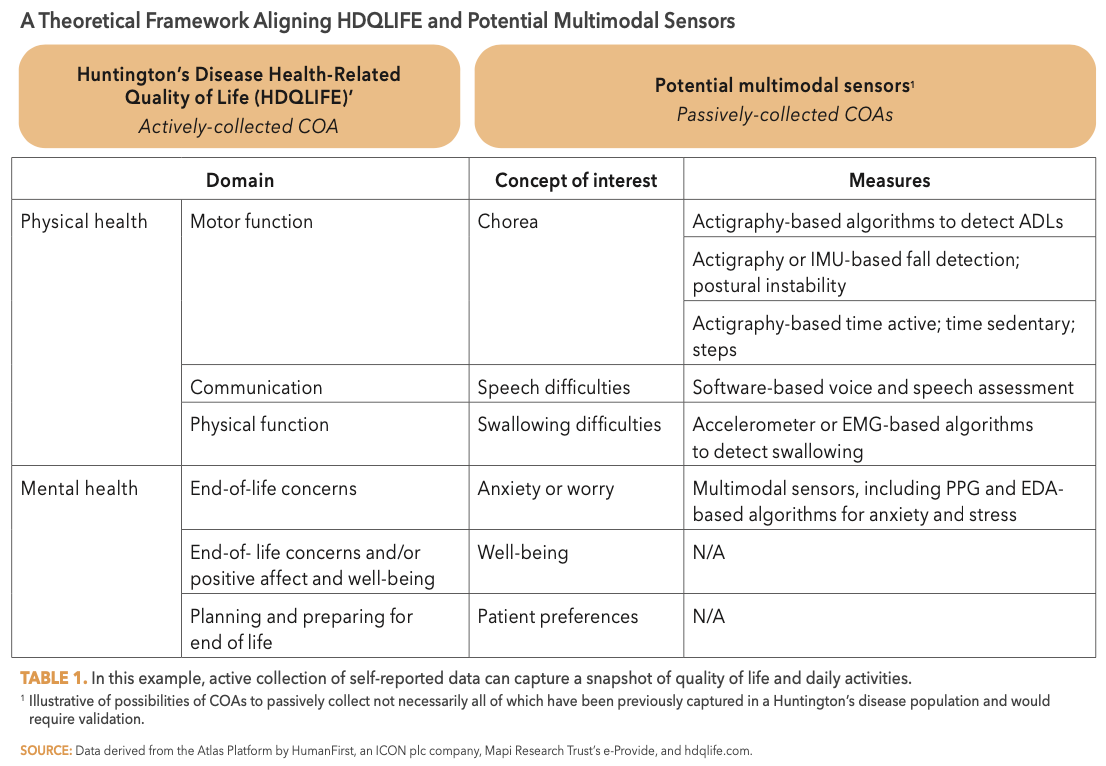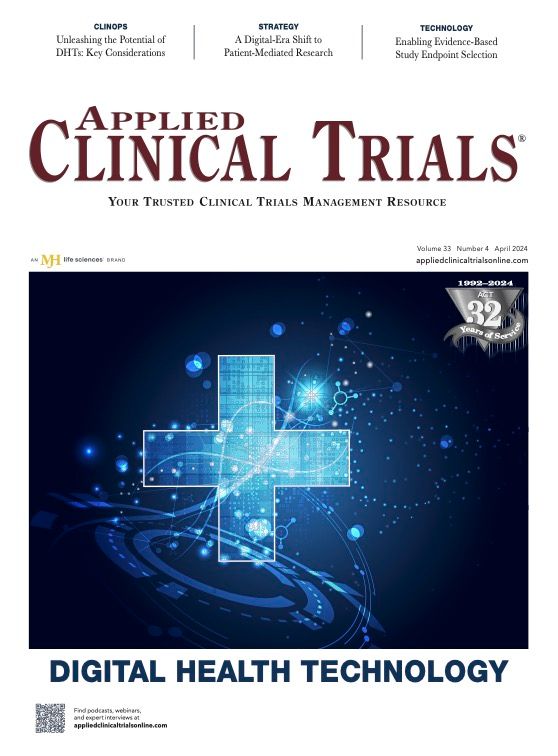Enabling Evidence-Based Study Endpoint Selection
Harnessing advances in digital health technologies for a more precision-measured approach.



Over the past decade, study sponsors have increasingly incorporated digital health technologies (DHTs) and digital measures into clinical trials across all study phases, particularly as new regulatory frameworks and guidelines supporting the use of precision measures are published.1-3 The ability to capture measures outside of traditional clinical settings has refocused what it means to have patients at the heart of the trial experience. Selecting measures that reflect the meaningful aspects of health of an individual, such as independently purchasing groceries, the ability to lift a grandchild, or walking upstairs without needing a break, are crucial to bringing a successful drug to market.4
Without selecting the right, patient-centered measures, a clinical trial is more likely to not find a therapeutic benefit and, therefore, the drug will not gain regulatory approval or qualify for reimbursement.5 It is also just as important to the patient experience and trial success to select the right assessment for data collection of the study endpoint, particularly as clinical trials are steadily becoming more complex with more endpoints. From 2015 to 2021, endpoints in Phase III trials increased 37%, to an average of 25.8 per study.6 Adding unnecessary measures to a clinical trial is not only costly, but can also increase patient and study-site burden and introduce risk for lost or missing data and poor adherence. A key way to begin simplifying trials is by leveraging a precision measures approach to find the right measure for the right patient.
Digital within the precision measures ecosystem
Digital measures are just one part of the precision measurement ecosystem, which includes actively- and passively-collected clinical outcome assessments (COAs), digital and traditional biomarkers, labs, imaging and even real-world data (RWD). Any combination of these precision measures can be used to confirm that a drug demonstrates a significant therapeutic benefit.
Often, to assess how an individual feels, functions, and survives, researchers will use COAs. A recent publication provided alignment on standard language and further definition of COA reporting types.7 “Actively-collected” COAs are traditionally obtained as patient-reported outcomes (PROs), clinician- or observer-reported outcomes (ClinROs/ObsROs), or standardized tasks completed by participants (PerfO).8
A DHT has the ability to collect digital biomarkers or clinical outcome assessments. When a DHT reports COA data, it is considered “actively-collected” if the participant performs a standardized task (e.g., a PerfO), or “passively-collected” if it captures the participant’s free-living activities.7 And while digital measures have gained acceptance and maturity, they are still often used as supplementary measures alongside their more traditional COA counterparts, which can lead to capturing duplicative or highly similar measures.7
Each COA type has strengths and limitations. Digital measures can be used to bring in passively collected, objective data, but they are not always the most appropriate or best measure available for certain use cases and clinical populations, nor do they represent how a patient subjectively perceives, feels, or experiences the disease. Similarly, the traditional, actively-collected COAs like questionnaires may not always be the most practical or robust way to capture the concept of interest in a trial. The choice of selection of the most appropriate measure should take multiple facets of the instrument properties into account.
When researchers do try to explore the trade-off scenarios of which COA to select as the most fit-for-purpose assessment type, they often find themselves navigating and evaluating disparate sources of evidence, technical specifications, regulatory information, and other crucial factors, making the decision process time-consuming and difficult. Comparison of relevant data elements related to all potential measures and across various data sources manually is indeed a labor-intensive effort. There is the need to create a single framework and harmonized ontology to view the parallel data elements of active and passive COAs that facilitates side-by-side comparisons of these measures.
An ontological framework for COA comparison
The previously mentioned recent publication also outlined a unified framework that facilitates comparison of actively-collected and passively-collected COAs, and makes the case in examples of pulmonary and dermatological conditions.7 This framework is designed based on an ontological structure grounded in measurement properties to provide a structured way to identify and evaluate previously incomparable data elements of actively- and passively-collected COAs. These key elements include therapeutic area, medical condition or indication, concept of interest, and measures, which all serve to evaluate the gaps and overlaps in measurement collection. Each assessment type’s unique elements can still be observed and evaluated independently as part of the protocol development process.
The ability to compare across measurement types offers a streamlined process to find the measures that matter to patients. This enhances efficiency in decision-making around which tools and technologies are the most appropriate, and brings the focus back onto the patient, which is ultimately required by regulatory bodies to ensure drugs are treating the most meaningful aspects of health.4,5
Areas for opportunity
Leveraging these clear and structured ontologies allows for the advancement of the industry at large—particularly to coalesce around critically important shared language, definitions, and mental models for how to incorporate the changing landscape of precision measures.
Here, we expand on this model with a proof-of-concept outline of the various precision measures that are important in the neurological condition of Huntington’s disease, thus enabling rapid, evidence-based measurement selection.
Framework in practice: A use case in neurology
Huntington’s disease, a condition that affects motor movements, cognition, and behavior, understandably touches all aspects of a patient’s life.9 Using a PRO assessment such as the Huntington’s Disease Health-Related Quality of Life (HDQLIFE) questionnaire, active collection of self-reported data can capture a snapshot of quality of life and daily activities. Domains in this section encompass a wide range of physical and mental aspects, such as the impact of chorea on one’s ability to perform daily tasks and physical activities, and speech and swallowing difficulties, as well as the mental and emotional impact and end-of-life considerations. (See Table 1 below).

Aligning the framework to understand where overlap may occur can help researchers make crucial trade-off decisions, such as whether to administer the full HDQLIFE, the short-form version, or even concluding that individual domain scores would be the better choice.* Using a shared ontological framework to assess which domains could be captured passively via DHTs and which are best suited to remain as active collection can help eliminate redundancies in data collected, as well as reduce administration time for patients and study teams or clinicians.
With a unified data model, a clearer picture can emerge of where alignment between passively and actively-collected measurements for study endpoints can occur. The ultimate benefit of this framework is its ability to provide side-by-side comparisons of actively- and passively-collected COAs, thus reducing patient-burden and enabling rapid, evidence-based selection.
Marcelo Alves Favaro, Associate Outcomes Researcher, MAPI Research Trust; Caprice Sassano, Research Lead - Applied Sciences, HumanFirst, an ICON company; Roya Sherafat, MD, PhD, Scientific Director, MAPI Research Trust
* When considering sub-scales and individual domains, it is important to make a note on the validity and other psychometric properties of the instrument at that level and whether they meet the necessary threshold of evidence for use in each specific context (study design and type of endpoints).
References
1. Marra, C.; Chen, J.L.; Coravos, A.; Stern, A.D. Quantifying the Use of Connected Digital Products in Clinical Research. NPJ Digit Med. 2020. 3 (50). https://doi.org/10.1038/s41746-020-0259-x
2. FDA, Using Artificial Intelligence & Machine Learning in the Development of Drug and Biological Products (2023). https://www.fda.gov/media/167973/download?attachment
3. FDA, Framework for the Use of Digital Health Technologies in Drug and Biological Product Development (2023). https://www.fda.gov/media/166396/download?attachment
4. Manta, C.; Patrick-Lake, B.; Goldsack, J.C. Digital Measures that Matter to Patients: A Framework to Guide the Selection and Development of Digital Measures of Health. Digit Biomark. 2020. 15 (3), 69-77. https://pubmed.ncbi.nlm.nih.gov/33083687/
5. FDA, CDER Patient-Focused Drug Development (February 14, 2024). https://www.fda.gov/drugs/development-approval-process-drugs/cder-patient-focused-drug-development
6. Protocol Design Scope and Execution Burden Continue to Rise, Most Notably in Phase III. Tufts Center for the Study of Drug Development Impact Rep. 2023. 25 (3), 1–4. https://9468915.fs1.hubspotusercontent-na1.net/hubfs/9468915/May-June%202023%20-%20Protocol%20Scope%20and%20Execution_Page_1.jpg
7. Campbell, C.M.; Webster, C.; Parisi, M.; et al. An Aligned Framework of Actively-Collected and Passively-Monitored Clinical Outcome Assessments (COAs) for Measure Selection. npj Digit. Med. 2024. 7 (71). https://doi.org/10.1038/s41746-024-01068-x
8. BEST (Biomarkers, EndpointS, and other Tools) Resource. FDA-NIH Biomarker Working Group.2016. https://www.ncbi.nlm.nih.gov/books/NBK326791/
9. National Institute of Neurological Disorders and Stroke, Huntington’s Disease (2023). https://www.ninds.nih.gov/health-information/disorders/huntingtons-disease

Unifying Industry to Better Understand GCP Guidance
May 7th 2025In this episode of the Applied Clinical Trials Podcast, David Nickerson, head of clinical quality management at EMD Serono; and Arlene Lee, director of product management, data quality & risk management solutions at Medidata, discuss the newest ICH E6(R3) GCP guidelines as well as how TransCelerate and ACRO have partnered to help stakeholders better acclimate to these guidelines.
Funding Cuts Threaten Diversity in Clinical Research
June 27th 2025In this video interview, Kyle McAllister, co-founder, CEO, Trially, discusses how recent federal funding cuts are likely to undermine research focused on underrepresented populations, and why long-term investment in community-based studies is essential to closing persistent health equity gaps.
Improving Relationships and Diversifying the Site Selection Process
April 17th 2025In this episode of the Applied Clinical Trials Podcast, Liz Beatty, co-founder and chief strategy officer, Inato, discusses a number of topics around site engagement including community-based sites, the role of technology in improving site/sponsor relationships, how increased operational costs are impacting the industry, and more.
Beyond the Molecule: How Human-Centered Design Unlocks AI's Promise in Pharma
June 23rd 2025How human-centered AI that is focused on customer, user, and employee experience can drive real transformation in clinical trials and beyond by aligning intelligent technologies with the people who use them.